QR Code Component

Solution retrospective
Please, I can't seem to get the media query right. Can anyone help?
Please log in to post a comment
Log in with GitHubCommunity feedback
- @devriquesant
Hello Ayoola-Emmanuel
Congratulations for completing this challenge!!
✏️ Here is a possible answser to your question, but before, here are some tips and suggestions for this and your future projects ;) ✏️
1. 🚀 Contain your "main" content in a "main" tag:
-
<main>is a semantic element from HTML which provides accessibility and organization for your web page; -
semantic elements provides detailed info about the contents in your page.
-
Others semantic elements includes:
<header>,<footer>,<figure>,<figcaption>... -
To implement this, you should exchange the
<div class="book">for<main>and wrap all the necessary and main content of your page -
Start practising it and you will be more familiarized to do it in future projects.
2. 📱 Build a responsive web page:
-
The use of
pxunit to dimension your components in the page gives it a appearance of static. -
To build a more responsive one, you should start to use relative length units to adequate the page components to a device screen.
-
That's why your media query is not working!!!
-
You made it work in the screen dimension in a certain range, but there is a lack of use of these relative units, as
vworvh, that makes the web page more responsive, try it with few components like a div and then expore to more components! :) -
To deeper details, take a look at it
Overall you did a good job!! Keep coding!! I'm sure you will discover new things and become even better
Here, take a star for achieving it: 🌟 <- it's a glowing star if you're seeing a rectangle :)
-
Join our Discord community
Join thousands of Frontend Mentor community members taking the challenges, sharing resources, helping each other, and chatting about all things front-end!
Join our Discord